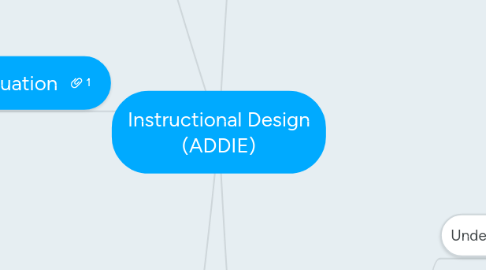
1. Analysis
1.1. Task
1.1.1. What tasks are performed?
1.1.2. How frequently are they performed?
1.1.3. How important is each task?
1.1.4. What knowledge is needed to perform the task?
1.1.5. How difficult is each task?
1.1.6. What kinds of training are available?
1.2. Learner
1.2.1. Who is doing the learning?
1.2.2. What are their circumstances?
1.3. Content
1.3.1. What is being taught?
2. Implementation
2.1. Manage time effectively
2.2. Get your students' attention
2.3. Ensure proficiency
2.4. Streamline procedures
3. Evaluation
3.1. Formative
3.1.1. Are the students receiving feedback?
3.1.1.1. Surveys
3.1.1.2. Polls
3.1.1.3. Self Assessments
3.1.1.4. Questionnaires
3.1.1.5. Tech Integration
3.1.1.5.1. SMART Response
3.1.1.5.2. Google Forms
3.1.1.5.3. Socrative
3.1.1.5.4. Turning Point
3.1.2. Performance goal
3.1.2.1. Make progress
3.2. Summative
3.2.1. Are the students receiving a grade?
3.2.1.1. Written Test
3.2.1.1.1. Fill in the Blank
3.2.1.1.2. True or False
3.2.1.1.3. Multiple Choice
3.2.1.1.4. Essay
3.2.1.2. Performance
3.2.1.2.1. Portfolio
3.2.1.2.2. Recital
3.2.1.2.3. Play
3.2.2. Mastery goal
3.2.2.1. Content knowledge
4. Development
4.1. Gagne's 9 Events
4.1.1. Gain Attention
4.1.2. Objectives
4.1.3. Stimulate Recall
4.1.4. Present Content
4.1.5. Provide Guidance
4.1.6. Ellicit Performance
4.1.7. Feedback
4.1.8. Assess
4.1.9. Retention/Transformation
4.2. UDL
4.2.1. Provide Multiple Means of Representation
4.2.1.1. Provide options for perception
4.2.1.2. Provide options for language, mathematical expressions, and symbols
4.2.1.3. Provide options for comprehension
4.2.1.3.1. Make it explicit!
4.2.2. Provide Multiple Means of Action and Expression
4.2.2.1. Provide options for physical action
4.2.2.1.1. Get the students out of their seats, make it interesting and active
4.2.2.2. Provide options for expression and communication
4.2.2.2.1. Graphic organizers
4.2.2.3. Provide options for executive functions
4.2.2.3.1. Scaffolding
4.2.3. Provide Multiple Means of Engagement
4.2.3.1. Provide options for recruiting interest
4.2.3.2. Provide options for sustaining effort and persistence
4.2.3.3. Provide options for self-regulation
4.2.4. Resources available for all students
4.3. Differentiation
4.3.1. Similar to UDL...
4.3.1.1. Content
4.3.1.2. Process
4.3.1.3. Product
4.3.1.4. Environment
4.3.2. Recognition
4.3.2.1. Learning "What"
4.3.3. Strategy
4.3.3.1. Learning "How"
4.3.4. Affect
4.3.4.1. Learning "Why"
4.3.5. Makes resources available to students who need accommodations
4.4. SMCM Lesson Plan
5. Design
5.1. Understanding by Design
5.1.1. Stage 1. Desired Results
5.1.1.1. What should students know?
5.1.1.2. What should students be able to do?
5.1.1.3. What essential questions will be explored?
5.1.1.4. What enduring understandings are desired?
5.1.2. Stage 2. Evidence
5.1.2.1. How will we know if students have reached desirable results?
5.1.2.2. How will we evaluate student performance?
5.1.2.3. What will we accept as evidence of proficiency?
5.1.3. Stage 3. Learning Plan
5.1.3.1. WHERE TO
5.1.3.1.1. W - help students know where the unit is going/what is expected; help teacher know where students are coming from
5.1.3.1.2. H - hook students, hold their interest
5.1.3.1.3. E - equip students, help them experience and explore
5.1.3.1.4. R - provide opportunities to rethink and revise
5.1.3.1.5. E - allow students to evaluate their work and its implications
5.1.3.1.6. T - be tailored/personalized to different needs, interests, and abilities of learners
5.1.3.1.7. O - be organized to maximize initial and sustained engagement + effective learning
5.1.4. "Backwards Design"
5.1.4.1. Thinking about long-term goals and working backwards
5.1.4.2. Seeks to avoid aimless activities and creates a goal
5.2. Setting Objectives
5.2.1. ABCD Model
5.2.1.1. A. Audience
5.2.1.2. B. Behavior
5.2.1.3. C. Condition
5.2.1.4. D. Degree
5.2.2. Enduring Understandings
5.2.2.1. The big, broad concepts that we find important
5.2.2.2. Important understandings
5.2.2.2.1. Students should retain after they’ve forgotten many of the details
5.2.2.3. Two or more concepts combined to make a relationship
5.2.2.3.1. Relational statement
5.2.2.4. Generalization = EU
5.2.3. Essential Questions
5.2.3.1. Needs to explain "how" or "why"
5.2.3.1.1. Formula: "How" or "Why" linking two nouns with a verb
5.2.3.2. Based on broad concepts
5.2.3.3. Based on transferable generalizations
5.2.3.4. Depth, rather than breadth
5.2.3.4.1. There should only be one or two EQ's per unit!
5.2.3.5. Can be answered differently based on viewpoints and perspectives
5.2.3.6. Criteria
5.2.3.6.1. Each child should be able to understand the question.
5.2.3.6.2. The language of the questions should be written in broad, organizational terms.
5.2.3.6.3. The question should reflect your conceptual priorities.
5.2.3.6.4. Each question should be distinct and substantial.
5.2.3.6.5. Questions should not be repetitious.
5.2.3.6.6. The questions should be realistic given the amount of time allocated for the unit or course.
5.2.3.6.7. There should be a logical sequence to a set of essential questions.
5.2.3.6.8. The questions should be posted in the classroom.
5.3. Bloom's Taxonomy
5.3.1. Encourage Higher Order Thinking!
5.3.1.1. Analyzing
5.3.1.2. Evanuating
5.3.1.3. Creating
5.4. Gradual Release of Responsibility
5.4.1. I do it
5.4.2. We do it
5.4.3. You do it

